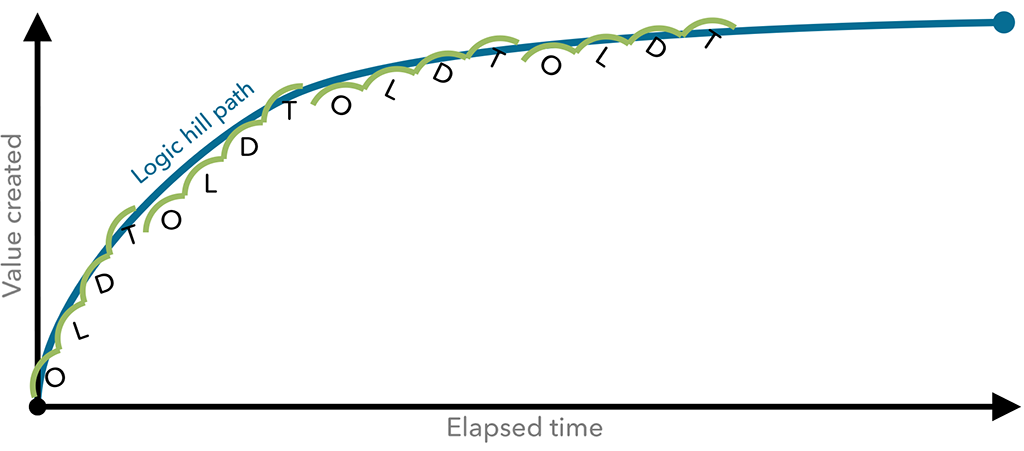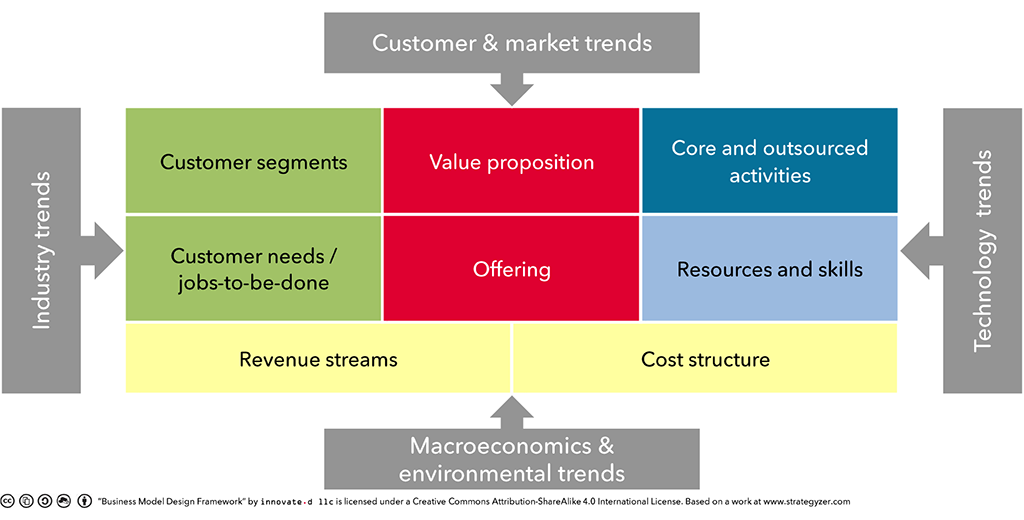Classical strategy development frameworks focus on data gathering, analysis, fact finding, followed by a deductive strategy construction approach. They are built on solid theoretical foundations, but often are static, rely on precise forecasts about an uncertain future, and lack practical relevance. Strategy becomes an annual exercise that does not ultimately lead to the expected value creation results. Design thinking based strategy development focuses on reducing the complexity early on in the process by iteratively observing, learning, designing, and validating. Prototyping ideas, using intuition, and following an abductive approach leads to implementable results quickly. Initial results are refined until a sufficiently solid and durable strategy has been developed.
Have you ever been involved in the development or review of a business strategy? Then you are probably aware of the lengthy data gathering and analysis phases associated with this exercise. And have you tried to apply numerous theoretical framework that seem to work well when explained using case studies but fail to address specific practical issues at hand. Dogmatic, delivery-based methodologies are often indoctrinated by consultants, failing to integrate stakeholders in a participatory way into the strategy process. At worst, the results from a strategy development exercise end up as a 500+ page binder or PowerPoint presentation (by the way, I have hardly ever seen such decks using the Keynotes software) with recommendations never implemented.
Although your strategy development experience may not be that horrifying, I am sure that you can relate to some of these observations. Being an interested person by nature (and by profession), I tried to figure out why this is the case, and especially what can be done to steer strategy development in an efficient and especially effective way toward durable success.
But let me start by describing a generic observation made when reviewing different strategy development approaches.
TWO STRATEGY SCHOOLS
There exist multiple different schools on developing business strategies. In this insight, I focus on two of them, the process school and the design thinking school.
PROCESS SCHOOL
Process based strategy development approaches start by gathering all sorts of data about the unknown, followed by an analysis phase providing structure through synthesis. They follow the analysis pathway, shown in Exhibit 1, and are deductive in nature. Most universities and MBA programs, as well as a large portion of academic literature, focus on process-based strategy development. Examples are Porter’s five forces framework, the BCG portfolio matrix, or the St. Gallen GMN, to name just a few. These approaches are well founded in theory and have a long-standing history.
DESIGN THINKING SCHOOL
The design thinking school, which initially grew out of creative faculties, like architecture, or industrial design, have a more recent history. Rather than being based on a theoretical foundation, design thinking strategists aim at prototyping, that is, trying out new ideas, until a sufficiently sound strategy, has been developed. They start by introducing clarity through iteratively observing and learning, translated rapidly into strategy prototypes. Data gathering focuses on validating the prototypes rather than fact finding. The approach is abductive.
COMPARISON
The key difference between design thinking and process-based strategy development approaches is when structure is introduced into knowledge. Design thinking follows the logic hill pathway, whereas process schools prefer the analysis pathway.
Design thinking makes strategy development more tangible to practitioners. The complexity is reduced early on in the process and the focus is set on on aspects that matter most, through simplifying understanding and promoting participation. Reasonable strategies are developed in a much shorter time, when compared to process-based approaches. The drawback is, that poor observing, and learning capabilities may lead to missing solutions and ending up with a sub-optimal strategy.

UNDERSTANDING DESIGN THINKING
Design thinking is a generic term used to describe approaches and frameworks focusing on a four-step iterative process for solving wicked problems, which I call the OLDT process.
- O – Observe the strategy problem, namely, customers, competitors, capabilities, and the environment.
- L – Learn through providing structure to the observed and generating knowledge that is relevant in the context of strategy design.
- D – Design prototype solutions of the future strategy based on the knowledge learned from the observations made.
- T – Validate the prototyped strategies through testing assumptions and relationships relying on real customers.
A key advantage of design thinking is that it allows climbing the logic hill fast, reducing complexity, and offering initial results quickly. Irrelevant data gathering, and analysis can be avoided without losing insight. Exhibit 1 illustrates how the OLDT design thinking process allows to iteratively introduce structure into the complex strategy problem without spending huge amount of efforts on fact finding.
DESIGN THINKING BASED STRATEGY DEVELOPMENT
Any good strategy, whether competitive or blue ocean, is based on a sound business model design, relying on four components
- Customers and their needs or jobs-to-be-done (green),
- a value proposition (red),
- a tailored value chain, focusing on activities, resources, and skills (blue),
- sound financials (yellow),
and considering the surrounding external environment (dark grey), as shown in Exhibit 2.

- Observe customers in their natural environment to identify unsatisfied needs and jobs-to-be-done. The needs may or may not be identified by the customers themselves. They may even not yet exist.
- Derive a value proposition that satisfies the identified needs, focusing on alleviating the customer’s pains and creating significant gains, helping the customers get their jobs done.
- Test whether or not the value proposition designed is a fit for the identified needs. Adjust the value proposition until you are completely satisfied.
- Design a value chain relying on capabilities around delivering the developed value proposition. Describe how the value proposition is defined, including core and outsourced activities, resources, and skills.
- Validate the feasibility of the designed value chain through building and testing prototypes.
- Associate financials to the value chain for producing the developed value proposition. Identify key cost drivers and describe the proposed revenue model.
- Confirm financial soundness of the designed business model.
- Conclude the strategy development exercise by answering Porter’s five questions for a successful strategy.
LESSONS LEARNED
- Using a design thinking based approach to strategy development leads to success faster than traditional process based methods do.
- Data gathering, and analysis should be focused on those areas that really matter in a “just-in-time” approach, avoiding spending time on irrelevant analysis.
- Business strategy developed using design thinking are implementable because their soundness is continuously tested and validated throughout the development process.
- Design thinking as a framework improves communication with all stakeholders because it relies on concrete practical prototypes rather than abstract theoretical frameworks.
